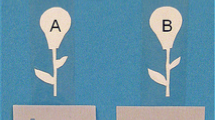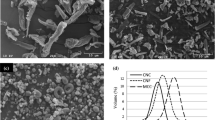Abstract
Bionanocomposites of poly(lactic acid) (PLA) and chemically modified, nanofibrillated cellulose (NFC) powders were prepared by extrusion, followed by injection molding. The chemically modified NFC powders were prepared by carboxymethylation and mechanical disintegration of refined, bleached beech pulp (c-NFC), and subsequent esterification with 1-hexanol (c-NFC-hex). A solvent mix was then prepared by precipitating a suspension of c-NFC-hex and acetone-dissolved PLA in ice-cold isopropanol (c-NFC-hexsm), extruded with PLA into pellets at different polymer/fiber ratios, and finally injection molded. Dynamic mechanical analysis and tensile tests were performed to study the reinforcing potential of dried and chemically modified NFC powders for PLA composite applications. The results showed a faint increase in modulus of elasticity of 10 % for composites with a loading of 7.5 % w/w of fibrils, irrespective of the type of chemically modified NFC powder. The increase in stiffness was accompanied by a slight decrease in tensile strength for all samples, as compared with neat PLA. The viscoelastic properties of the composites were essentially identical to neat PLA. The absence of a clear reinforcement of the polymer matrix was attributed to poor interactions with PLA and insufficient dispersion of the chemically modified NFC powders in the composite, as observed from scanning electron microscope images. Further explanation was found in the decrease of the thermal stability and crystallinity of the cellulose upon carboxymethylation.







Similar content being viewed by others
References
Auras R, Harte B, Selke S (2004) Macromol Biosci 4:835–864
Garlotta D (2001) J Polym Environ 9:63–84
Siro I, Plackett D (2010) Cellulose 17:459–494
Samir M, Alloin F, Dufresne A (2005) Biomacromolecules 6:612–626
Chazeau L et al (1999) J Appl Polym Sci 71:1797–1808
Favier V, Chanzy H, Cavaille JY (1995) Macromolecules 28:6365–6367
Marchessault RH, Morehead FF, Walter NM (1959) Nature 184:632–633
Turbak AF, Snyder FW, Sandberg KR (1983) J Appl Polym Sci Symp 37:815–827
Oksman K et al (2006) Compos Sci Technol 66:2776–2784
Mathew AP et al (2006) In: Oksman K, Sain M (eds) Cellulose nanocomposites: processing, characterization, and properties. American Chemical Society, Washington, pp 114–131
Petersson L, Kvien I, Oksman K (2007) Compos Sci Technol 67:2535–2544
Bondeson D, Oksman K (2007) Compos A Appl Sci Manuf 38:2486–2492
Bondeson D, Oksman K (2007) Compos Interfaces 14:617–630
Iwatake A, Nogi M, Yano H (2008) Compos Sci Technol 68:2103–2106
Suryanegara L, Nakagaito AN, Yano H (2009) Compos Sci Technol 69:1187–1192
Tingaut P, Zimmermann T, Lopez-Suevos F (2010) Biomacromolecules 11:454–464
Jonoobi M et al (2010) Compos Sci Technol 70:1742–1747
Eyholzer C et al (2010) Cellulose 17:19–30
Lee K-Y, Blaker JJ, Bismarck A (2009) Compos Sci Technol 69:2724–2733
Fukuzumi H et al (2009) Biomacromolecules 10:162–165
Leza ML et al (1989) Die Angewandte Makromolekulare Chemie 168:195–203
Rosenau T et al (2003) Polymer 44:6153–6158
Acknowledgments
The authors express their thanks to Aji Mathew and Maiju Hietala for their help during extrusion and injection molding, and Christian Walder (EMPA) for his support concerning the melt shear tests. The State Secretariat for Education and Research (SER) is gratefully acknowledged for the financial support of this work.
Author information
Authors and Affiliations
Corresponding author
Rights and permissions
About this article
Cite this article
Eyholzer, C., Tingaut, P., Zimmermann, T. et al. Dispersion and Reinforcing Potential of Carboxymethylated Nanofibrillated Cellulose Powders Modified with 1-Hexanol in Extruded Poly(Lactic Acid) (PLA) Composites. J Polym Environ 20, 1052–1062 (2012). https://doi.org/10.1007/s10924-012-0508-4
Published:
Issue Date:
DOI: https://doi.org/10.1007/s10924-012-0508-4




